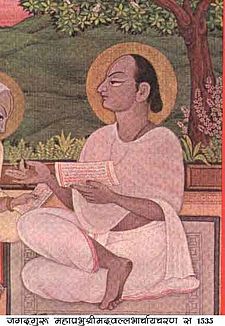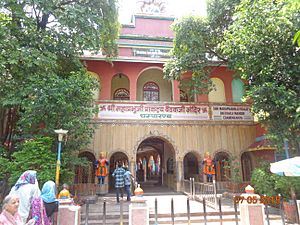Vallabha facts for kids
Quick facts for kids Jagadguru Aacharya Shree Vallabhacharya ji Mahaprabhu |
|
|---|---|
 |
|
| Birth Date | 27 April 1479 Champaran (now in Gariaband district, Chhattisgarh, India) |
| Died on | 26 June 1531 (aged 52) Banaras (now in Uttar Pradesh, India) |
| Philosophy | Shuddhadvaita, Pushtimarg |
Vallabhacharya (born 1479, died 1531), also known as Vallabha, was an important Indian thinker. He started a special way of worshipping Krishna called Pushtimarg. He also taught a philosophy called Shuddhadvaita, which means "pure non-duality."
Vallabha was born in Champaran, India. His family had moved there from Varanasi because they feared an invasion. As a child, Vallabha studied ancient Hindu texts like the Vedas and Upanishads. He then traveled across India for 20 years. He became a key leader in the Bhakti movement, which focused on loving devotion to God.
Vallabha taught that people could find salvation through loving devotion to Krishna. He believed this was possible even for people living normal family lives, not just monks. This idea became very popular across India. His followers built 84 special places of worship, called Baithakjis, all over the country.
He wrote many books, including a commentary on the Vedanta Sutra called Anubhashya. His writings often focused on baby Krishna and his childhood fun. They also talked about a young Krishna protecting good people and defeating evil. His teachings are still very important in the Braj region of India.
Contents
Life of Vallabhacharya
Early Life and Birth
Vallabhacharya's family came from the Andhra region. They were a long line of Telugu Vaidiki Brahmins. They followed the teachings of Vishnu Swami. Stories say that the god Krishna promised Vallabha's ancestor, Yagnanarayana Bhatta, that he would be born into their family. This would happen after they completed 100 special fire ceremonies called Somayagnas.
By the time Vallabha's father, Lakshmana Bhatta, lived in Varanasi, the family had completed these ceremonies. Vallabhacharya was born to Lakshmana Bhatta and his mother Yellamma in 1479. This happened in Champaranya, which is now in Chhattisgarh.
The time Vallabhacharya was born was difficult. Many people in northern India were moving to escape invasions. His parents had to leave Varanasi quickly while his mother was pregnant. Because of the stress, Vallabha was born early. At first, he showed no signs of life. His parents left him under a tree, wrapped in cloth.
Followers believe that Krishna appeared to Vallabha's parents in a dream. Krishna told them that he himself had been born as their child. The parents rushed back and found their baby alive. He was protected by a circle of divine fire. His mother reached into the fire without getting hurt and brought her baby out. They named the child Vallabha, which means "dear one" in Sanskrit.
Education and Learning
Vallabhacharya started his education at age seven. He studied the four Vedas, which are ancient Hindu scriptures. He quickly became an expert in many different philosophical systems. He also learned about the ideas of Adi Shankara, Ramanuja, Madhvacharya, and Nimbarka. He even studied Buddhism and Jainism.
He was so smart that he could recite 100 mantras forwards and backward. People were very impressed by his knowledge. They called him Bala Saraswati, meaning "child Saraswati" (Saraswati is the goddess of knowledge). After studying until he was 11, he traveled to Vrindavan.
Winning a Great Debate
When Vallabhacharya was 11, a big debate happened in the court of King Krishnadevaraya. This was in Vijayanagara. The debate was between followers of Madhva and Shankara. They argued about whether God is dualistic (separate from us) or non-dualistic (one with us).
Vallabhacharya was given a chance to speak in this important discussion. The debate lasted for 27 days. Vallabhacharya won the debate with his strong arguments. King Krishnadevaraya honored him with a special ceremony. He was given the titles 'Acharya' (teacher) and 'Jagadguru' (world teacher). The king offered him a lot of gold. Vallabhacharya politely refused most of it. He only kept seven gold coins to make ornaments for the deity Vithoba in Pandharpur. He gave the rest of the gold to poor, learned Brahmins.
Travels Across India
Vallabhacharya traveled across India three times, always walking barefoot. He wore simple white clothes. He gave talks about the Bhagavata Purana in 84 different places. These 84 spots are now known as Chaurāsi Baithak and are important pilgrimage sites. Each year, he spent four months in Vraja.
Starting Pushtimarg
It is believed that when Vallabhacharya arrived in Shri Gokul, he thought about how to help people find the right path to devotion. He meditated on Krishna. Krishna appeared to him in a vision as Shrinathji. In this vision, Krishna revealed the 'Brahma Sambandha'. This is a special mantra for dedicating oneself to Krishna.
Vallabhacharya shared this experience with his disciple, Damodardasa. He explained the meaning of the mantra. Damodardasa became the first person to be initiated into this new path by Vallabhacharya.
Vallabhacharya wanted to spread his message of devotion and God's grace, called Pushtimarg (path of grace). He traveled India, performing a special initiation ceremony. Thousands of people became his followers. The stories of 84 of his most devoted followers are famous in Pushtimarg literature.
Family Life and Passing
Vallabhacharya had planned to remain unmarried his whole life. However, the deity-guru Vithoba told him to marry and live as a householder. Shrinathji himself said he would be born as Vallabha's second child. So, Vallabhacharya married Mahalaxmi. They had two sons, Gopinathji and Vitthalnathji (also known as Gusainji).
At the age of 52, Vallabhacharya left his body in the Ganges river in Kasi.
According to Pushti Marg stories, Shrinathji told Vallabhacharya three times to leave his worldly life. Vallabhacharya accepted the third command. He went to Kasi and formally gave up worldly life. He took a vow of silence. He lived in a small hut for about a week. He spent his last days thinking about Krishna.
His family gathered to see him one last time. When asked for advice, Vallabhacharya wrote three and a half Sanskrit verses in the sand. It is believed that Krishna himself appeared and completed the message with another verse and a half. This collection of verses is called ‘ShikshaSloki’.
Vallabhacharya entered the waters of the Ganges on the day of Rath Yatra festival. People saw a bright flame rise from the water. It went up to the sky and disappeared. This event is known as AsurVyamohLila.
Pushtimarg Teachings
Vallabhacharya's ideas were a key part of the Bhakti Movement. The path he created is special for its devotion to Krishna, especially Krishna as a child. It includes unique traditions, music, and festivals. Today, most of his followers live in North and West India. However, his temples are found all over the world.
Important Writings
Vallabhacharya wrote many books about philosophy and devotion. Some of his main works include:
- Anubhashya or Brahmsutranubhashya – This is a commentary on the Vedanta Sutra by Ved Vyas.
- Tattvaarth Dip Nibandh – These are essays about the basic ideas of spirituality. They have three chapters:
- Chapter 1: Shaastrarth Prakaran
- Chapter 2: Bhagavatarth Prakaran
- Chapter 3: Sarvanirnay Prakaran
- Subodhini – This is a commentary on the Shrimad Bhagavat Mahapuran.
- Shodash Granth – These are sixteen short poems. They teach his followers about how to live a devotional life.
He also wrote other works like Patravalamban, Madhurashtakam, and Purushottam Sahastranaam.
The Sixteen Books (Shodash Granthas)
To help his followers, Vallabhacharya wrote 16 short books in verse. These are known as the Shodasha Granthas. They answer questions from his followers. These verses explain the practical ideas of Pushtimarga.
The Shodasha Granthas are like a guiding light for followers. They talk about how to increase love for Krishna through Seva (service) and Smarana (remembering God). These books encourage and inspire followers on this path of grace. The main message of the Shodasha Granthas is to fully surrender to God. A Goswami (a spiritual teacher) can help someone start on this path of loving devotion and service to Krishna. The verses explain different types of followers and how to surrender. They also describe the rewards of service and give other practical advice. Followers are cared for by God's grace.
Here are some of the Shodasha Granthas:
- Shree Yamunastakam: A poem praising Shree Yamuna Maharani.
- Baala Bodhah: A guide for new followers on the path of devotion.
- Siddhant-Muktavali: A collection of the main principles of Pushtimarg.
- Pusti-Pravaha-Maryadabhedah: Explains different types of souls and how they receive God's grace.
- Siddhant-Rahasya: The secret meaning behind the principles.
- Navratna: Nine valuable instructions for a follower.
- Antah-Karan-Prabodhah: Comforting one's own heart.
- Vivek-Dhairy-Aashray: About wisdom, patience, and surrender.
- Shree Krushna Aashray: Taking shelter in Shree Krushna.
- Chatuhshloki: Four verses explaining the four principles of life for a Vaishnav.
- Bhakti-Vardhini: How to increase devotion.
- Jal-Bhed: Describes categories and qualities of a good speaker.
- Pancha-Padyaani: Five instructive verses on categories and qualities of a listener.
- Sannyasa-Nirnayah: A decision on taking renunciation.
- Nirodh-Lakshanam: Identifying signs of detachment.
- Seva-Phalam: The reward of serving the Lord.
See also
In Spanish: Vallabha para niños



